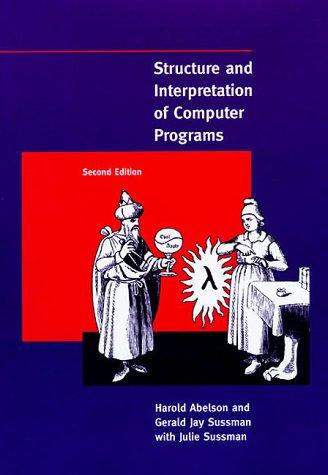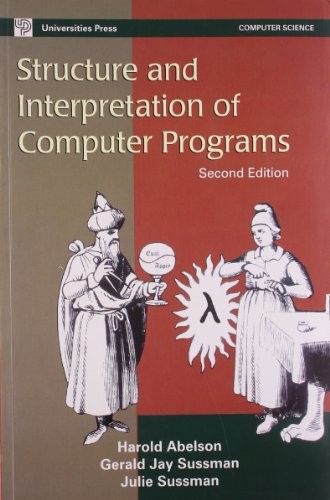Structure and interpretation of computer programs, second edition - Info and Reading Options
By Harold Abelson, Gerald Jay Sussman and Julie Sussman

"Structure and interpretation of computer programs, second edition" was published by MIT Press in 1996 - Cambridge, Mass, it has 883 pages and the language of the book is English.
“Structure and interpretation of computer programs, second edition” Metadata:
- Title: ➤ Structure and interpretation of computer programs, second edition
- Authors: Harold AbelsonGerald Jay SussmanJulie Sussman
- Language: English
- Number of Pages: 883
- Publisher: MIT Press
- Publish Date: 1996
- Publish Location: Cambridge, Mass
“Structure and interpretation of computer programs, second edition” Subjects and Themes:
- Subjects: ➤ Computer programming - LISP (Computer program language) - mirror - pdf.yt - Computer science - Electronic digital computers, programming - LISP (Langage de programmation) - Programmeren (computers) - Computers - Programmation (Informatique) - Programmierung - LISP - Programming - TI 99/4A (Computer) - LOGO (Computer program language) - TI 99/4 (Computer) - scheme - Computer systemsprogramming - Qa76.6 .a255 1985 - Qa 76.6 a141s 1985 - 001.64/2 - Computer programs - Computer programs, design
Edition Specifications:
- Pagination: xxviii, 855p.
Edition Identifiers:
- The Open Library ID: OL980232M - OL3267304W
- Library of Congress Control Number (LCCN): 96017756
- ISBN-10: 0262011530 - 0070004846
- All ISBNs: 0262011530 - 0070004846
AI-generated Review of “Structure and interpretation of computer programs, second edition”:
"Structure and interpretation of computer programs, second edition" Table Of Contents:
- 1- Foreword
- 2- Preface to the First Edition
- 3- Preface to the Second Edition
- 4- Acknowledgements
- 5- Building Abstractions with Procedures
- 6- The Elements of Programming
- 7- Expressions
- 8- Naming and the Environment
- 9- Evaluating Combinations
- 10- Compound Procedures
- 11- The Substitution Model for Procedure Application
- 12- Conditional Expressions and Predicates
- 13- Example: Square Roots by Newton's Method
- 14- Procedures as Black Box Abstractions
- 15- Procedures and the Processes They Create
- 16- Linear Recursion and Iteration
- 17- Tree Recursion
- 18- Orders of Growth
- 19- Exponentiation
- 20- Greatest Common Divisors
- 21- Example: Testing for Primality
- 22- Formulating Abstractions with Higher-Order Procedures
- 23- Procedures as Arguments
- 24- Constructing Procedures Using Lambda
- 25- Procedures as General Methods
- 26- Procedures as Returned Values
- 27- Building Abstractions with Data
- 28- Introduction to Data Abstraction
- 29- Example: Arithmetic Operations for Rational Numbers
- 30- Abstraction Barriers
- 31- What Is Meant By Data?
- 32- Extended Exercise: Interval Arithmetic
- 33- Hierarchical Data and the Closure Property
- 34- Representing Sequences
- 35- Hierarchical Structures
- 36- Sequences as Conventional Interfaces
- 37- Example: A Picture Language
- 38- Symbolic Data
- 39- Quotation
- 40- Example: Symbolic Differentiation
- 41- Example: Representing Sets
- 42- Example: Huffman Encoding Trees
- 43- Multiple Representations for Abstract Data
- 44- Representations for Complex Numbers
- 45- Tagged data
- 46- Data-Directed Programming and Additivity
- 47- Systems with Generic Operations
- 48- Generic Arithmetic Operations
- 49- Combining Data of Different Types
- 50- Example: Symbolic Algebra
- 51- Modularity, Objects, and State
- 52- Assignment and Local State
- 53- Local State Variables
- 54- The Benefits of Introducing Assigment
- 55- The Costs of Introducing Assignment
- 56- The Environment Model of Evaluation
- 57- The Rules for Evaluation
- 58- Applying Simple Procedures
- 59- Frames as the Repository of Local State
- 60- Internal Definitions
- 61- Modeling with Mutable Data
- 62- Mutable List Structures
- 63- Representing Queues
- 64- Representing Tables
- 65- A Simulator for Digital Circuits
- 66- Propogation of Constraints
- 67- Concurrency: Time Is of the Essence
- 68- The Nature of Time in Concurrent Systems
- 69- Mechanisms for Controlling Concurrency
- 70- Streams
- 71- Streams Are Delayed Lists
- 72- Infinite Streams
- 73- Exploiting the Stream Paradigm
- 74- Streams and Delayed Evaluation
- 75- Modularity of Functional Programs and Modularity of Objects
- 76- Metalinguistic Abstraction
- 77- The Metacircular Evaluator
- 78- The Core of the Evaluator
- 79- Representing Expressions
- 80- Evaluator Data Structures
- 81- Running the Evaluator as a Program
- 82- Data as Programs
- 83- Internal Definitions
- 84- Separating Syntactic Analysis from Execution
- 85- Variations on a Scheme—Lazy Evaluation
- 86- normal Order and Applicative Order
- 87- An Interpreter with Lazy Evaluation
- 88- Streams as Lazy Lists
- 89- Variations on a Scheme—Nondeterministic Computing
- 90- Amb and Search
- 91- Examples of Nondeterministic Programs
- 92- Implementing the Amb Evaluator
- 93- Logic Programming
- 94- Deductive Information Retrieval
- 95- How the Query System Works
- 96- Is Logic Programming Mathematical Logic?
- 97- Implementing the Query System
- 98- Computing with Register Machines
- 99- Designing Register Machines
- 100- A Language for Describing Register Machines
- 101- Abstraction in Machine Design
- 102- Subroutines
- 103- Using a Stack to Implement Recursion
- 104- Instruction Summary
- 105- A Register-Machine Simulator
- 106- The Machine Model
- 107- The Assembler
- 108- Generating Execution Procedures for Instructions
- 109- Monitoring Machine Performance
- 110- Storage Allocation and Garbage Collection
- 111- Memory as Vectors
- 112- Maintaining the Illusion of Infinite Memory
- 113- The Explicit-Control Evaluator
- 114- The Core of the Explicit-Control Evaluator
- 115- Sequence Evaluation and Tail Recursion
- 116- Conditionals, Assignments, and Definitions
- 117- Running the Evaluator
- 118- Compilation
- 119- Structure of the Compiler
- 120- Compiling Expressions
- 121- Compiling Combinations
- 122- Combining Instruction Sequences
- 123- An Example of Compiled Code
- 124- Lexical Addressing
- 125- Interfacing Compiled Code to the Evaluator
- 126- References
- 127- List of Exercises
- 128- Index
Read “Structure and interpretation of computer programs, second edition”:
Read “Structure and interpretation of computer programs, second edition” by choosing from the options below.
Search for “Structure and interpretation of computer programs, second edition” downloads:
Visit our Downloads Search page to see if downloads are available.
Find “Structure and interpretation of computer programs, second edition” in Libraries Near You:
Read or borrow “Structure and interpretation of computer programs, second edition” from your local library.
- The WorldCat Libraries Catalog: Find a copy of “Structure and interpretation of computer programs, second edition” at a library near you.
Buy “Structure and interpretation of computer programs, second edition” online:
Shop for “Structure and interpretation of computer programs, second edition” on popular online marketplaces.
- Ebay: New and used books.


